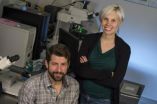(Press-News.org) A new screening process for tuberculosis (TB) infections in Canadian prisons could mean that more than 50 per cent of those screened won't undergo unnecessary treatment due to false positives.
According to research by Wendy Wobeser and medical resident Ilan Schwartz, a test for TB using interferon-gamma release assays (IGRA) will detect a pre-existing TB infection, or latent TB, that might not present itself for many years, or until the body becomes weakened by another source.
"It's fairly uncommon that latent TB will reactivate – only about a 10 per cent chance," says Dr. Wobeser, the study's lead author and an infectious diseases expert at Queen's. "That said, given the crowding in corrections facilities, the mass exposure of inmates to TB could be disastrous."
The IGRA test was developed in the last 10-15 years and diagnoses a latent TB infection. The body's immune system is provoked with a small amount of protein from the TB virus and if the body has previously been infected then a reaction will occur and the patient's blood will test positive for TB.
The pre-existing tuberculosis skin test (TST) for TB has been used for over 100 years but comes with two main limitations.
The current test requires two visits to determine the results: one to perform the test and then another visit a couple of days later to read the results.
Depending on the patient's exposure to other mycobacteria or the BCG vaccine, the current TB test can give many false positives.
The study group included representation from Public Health Agency of Canada (PHAC), Public Health Ontario (PHO), Correctional Services Canada (CSC) and the local public health agency. Inmates were tested at a Canadian intake institution before moving on to different corrections facilities. Ninety-six inmates tested positive for TB via the TST test. Only 31 of these inmates were confirmed as true latent TB infection when using the IGRA test.
"What I found surprising was just how much discordance there was between the TST and IGRA tests," says Dr. Schwartz, who was a medical resident at Queen's when he started this research. "Historically, all of those who tested TB-positive by the TST test would have been subjected to 12 months of drug treatments that can have considerable side effects."
IGRA tests can't prove that latent TB infections will progress into active TB until the patient begins to show symptoms. Better tools to predict who will go on to develop active (and potentially infectious) TB are being actively pursued.
"It's such a slow disease progression that it's hard for us to say with certainty who will actually go on to develop TB," says Dr. Wobeser. "I hope that this test will eventually be used in corrections and is able to reduce people who might otherwise be treated unnecessarily for latent TB."
INFORMATION:
New tuberculosis test more than skin deep
TB blood test could eliminate unnecessary treatment
2014-06-05
ELSE PRESS RELEASES FROM THIS DATE:
Seemingly invincible cancers stem cells reveal a weakness
2014-06-05
CAMBRIDGE, Mass. (June 5, 2014) – Metastatic cancer cells, which can migrate from primary tumors to seed new malignancies, have thus far been resistant to the current arsenal of anticancer drugs. Now, however, researchers at Whitehead Institute have identified a critical weakness that actually exploits one of these cells' apparent strengths—their ability to move and invade tissues.
"This is the first vulnerability of invasive cancer cells that we really understand," says Whitehead Member Piyush Gupta, whose lab's latest work is described in the June issue of the journal ...
New evidence links air pollution to autism, schizophrenia
2014-06-05
A new study published in the journal Environmental Health Perspectives describes how exposure to air pollution early in life produces harmful changes in the brains of mice, including an enlargement of part of the brain that is seen in humans who have autism and schizophrenia.
As in autism and schizophrenia, the changes occurred predominately in males. The mice also performed poorly in tests of short-term memory, learning ability, and impulsivity.
The new findings are consistent with several recent studies that have shown a link between air pollution and autism ...
New findings out on brain networks in children at risk for mental disorders
2014-06-05
DETROIT – Attention deficits are central to psychiatric disorders such as schizophrenia or bipolar disorder, and are thought to precede the presentation of the illnesses. A new study led by Wayne State University School of Medicine researcher Vaibhav Diwadkar, Ph.D. suggests that the brain network interactions between regions that support attention are dysfunctional in children and adolescents at genetic risk for developing schizophrenia and bipolar disorder.
"The brain network mechanisms that mediate these deficits are poorly understood, and have rarely been tackled ...
Rice developing mobile DNA test for HIV
2014-06-05
Rice University bioengineers are developing a simple, highly accurate test to detect signs of HIV and its progress in patients in resource-poor settings.
The current gold standard to diagnose HIV in infants and to monitor viral load depends on lab equipment and technical expertise generally available only in clinics, said Rice bioengineer Rebecca Richards-Kortum. The new research features a nucleic acid-based test that can be performed at the site of care.
Richards-Kortum, director of the Rice 360˚: Institute for Global Health Technologies, and her colleagues reported ...
Iowa State, Ames Lab researchers find the mechanism that forms cell-to-cell catch bonds
2014-06-05
AMES, Iowa – Certain bonds connecting biological cells get stronger when they're tugged. Those bonds could help keep hearts together and pumping; breakdowns of those bonds could help cancer cells break away and spread.
Those bonds are known as catch bonds and they're formed by common adhesion proteins called cadherins. Sanjeevi Sivasankar, an Iowa State University assistant professor of physics and astronomy and an associate of the U.S. Department of Energy's Ames Laboratory, has described catch bonds as "nanoscale seatbelts. They become stronger when pulled."
But how ...
Short nanotubes target pancreatic cancer
2014-06-05
Short, customized carbon nanotubes have the potential to deliver drugs to pancreatic cancer cells and destroy them from within, according to researchers at Rice University and the University of Texas MD Anderson Cancer Center.
Pristine nanotubes produced through a new process developed at Rice can be modified to carry drugs to tumors through gaps in blood-vessel walls that larger particles cannot fit through.
The nanotubes may then target and infiltrate the cancerous cells' nuclei, where the drugs can be released through sonication – that is, by shaking them.
The ...
LSU biologist James Caprio, Japanese colleagues identify unique way catfish locate prey
2014-06-05
BATON ROUGE – Animals incorporate a number of unique methods for detecting prey, but for the Japanese sea catfish, Plotosus japonicus, it is especially tricky given the dark murky waters where it resides.
John Caprio, George C. Kent Professor of Biological Sciences at LSU, and colleagues from Kagoshima University in Japan have identified that these fish are equipped with sensors that can locate prey by detecting slight changes in the water's pH level.
A paper, "Marine teleost locates live prey through pH sensing," detailing the work of Caprio and his research partners, ...
Termites, fungi and climate change
2014-06-05
Climate change models could have a thing or two to learn from termites and fungi, according to a new study released this week.
For a long time scientists have believed that temperature is the dominant factor in determining the rate of wood decomposition worldwide. Decomposition matters because the speed at which woody material are broken down strongly influences the retention of carbon in forest ecosystems and can help to offset the loss of carbon to the atmosphere from other sources. That makes the decomposition rate a key factor in detecting potential changes to the ...
Brazil leads the world in reducing carbon emissions
2014-06-05
As the world turns its attention to Brazil with the opening of the World Cup this month, many people around the globe know the country's soccer fame, but few realize that it is the world's leader in reducing carbon emissions. A new study published in Science magazine provides the first in-depth analysis of how Brazil reached this global-leader status and managed to increase its agriculture production at the same time.
"Brazil is known as a leading favorite to win the World Cup, but they also lead the world in mitigating climate change," says the study's lead author, ...
New isotopic evidence supporting moon formation via Earth collision with planet-sized body
2014-06-05
A new series of measurements of oxygen isotopes provides increasing evidence that the Moon formed from the collision of the Earth with another large, planet-sized astronomical body, around 4.5 billion years ago. This work will be published in Science* on 6th June, and will be presented to the Goldschmidt geochemistry conference in California on 11th June.
Most planetary scientists believe that the Moon formed from an impact between the Earth and a planet-sized body, which has been given the name Theia. Efforts to confirm that the impact had taken place had centred ...
LAST 30 PRESS RELEASES:
Structure of dopamine-releasing neurons relates to the type of circuits they form for smell-processing
Reducing social isolation protects the brain in later life
Keeping the heart healthy increases longevity even after cancer
Young adults commonly mix cannabis with nicotine and tobacco
Comprehensive review illuminates tau protein's dual nature in brain health, disease, and emerging psychiatric connections
Book prepares K-12 leaders for the next public health crisis
Storms in the Southern Ocean mitigates global warming
Seals on the move: Research reveals key data for offshore development and international ecology
Sports injuries sustained during your period might be more severe
World's first successful 2 Tbit/s free-space optical communication using small optical terminals mountable on satellites and HAPS
Can intimate relationships affect your heart? New study says ‘yes’
Scalable and healable gradient textiles for multi‑scenario radiative cooling via bicomponent blow spinning
Research shows informed traders never let a good climate crisis go to waste
Intelligent XGBoost framework enhances asphalt pavement skid resistance assessment
Dual-function biomaterials for postoperative osteosarcoma: Tumor suppression and bone regeneration
New framework reveals where transport emissions concentrate in Singapore
NTP-enhanced lattice oxygen activation in Ce-Co catalysts for low-temperature soot combustion
Synergistic interface engineering in Cu-Zn-Ce catalysts for efficient CO2 hydrogenation to methanol
COVID-19 leaves a lasting mark on the human brain
Scientists use ultrasound to soften and treat cancer tumors without damaging healthy tissue
Community swimming program for Black youth boosts skills, sense of belonging, study finds
Specific depressive symptoms in midlife linked to increased dementia risk
An ‘illuminating’ design sheds light on cholesterol
Who is more likely to get long COVID?
Study showcases resilience and rapid growth of “living rocks”
Naval Research Lab diver earns Office of Naval Research 2025 Sailor of the Year
New Mayo-led study establishes practical definition for rapidly progressive dementia
Fossil fuel industry’s “climate false solutions” reinforce its power and aggravate environmental injustice
Researchers reveal bias in a widely used measure of algorithm performance
Alcohol causes cancer. A study from IOCB Prague confirms damage to DNA and shows how cells defend against it
[Press-News.org] New tuberculosis test more than skin deepTB blood test could eliminate unnecessary treatment



